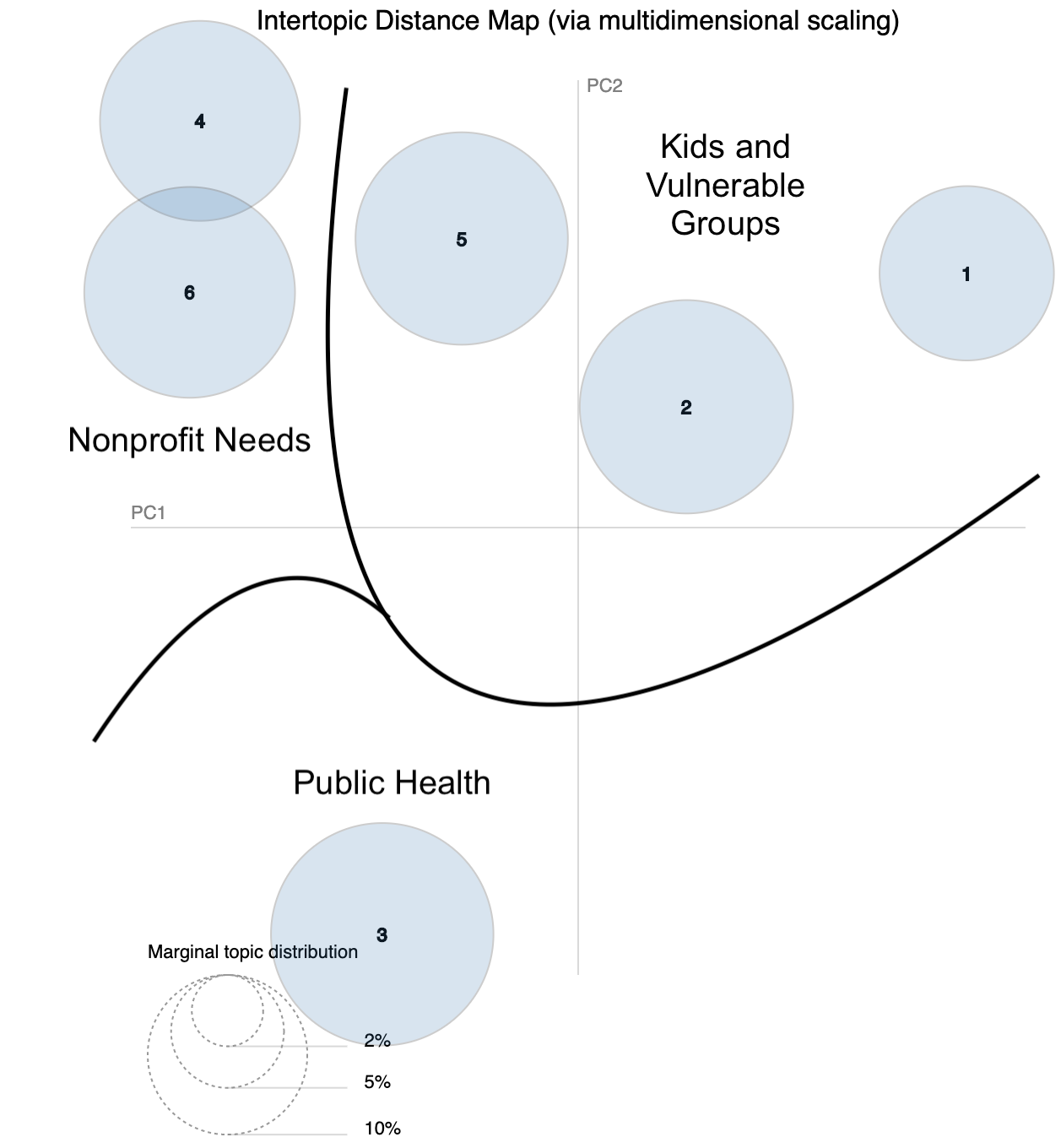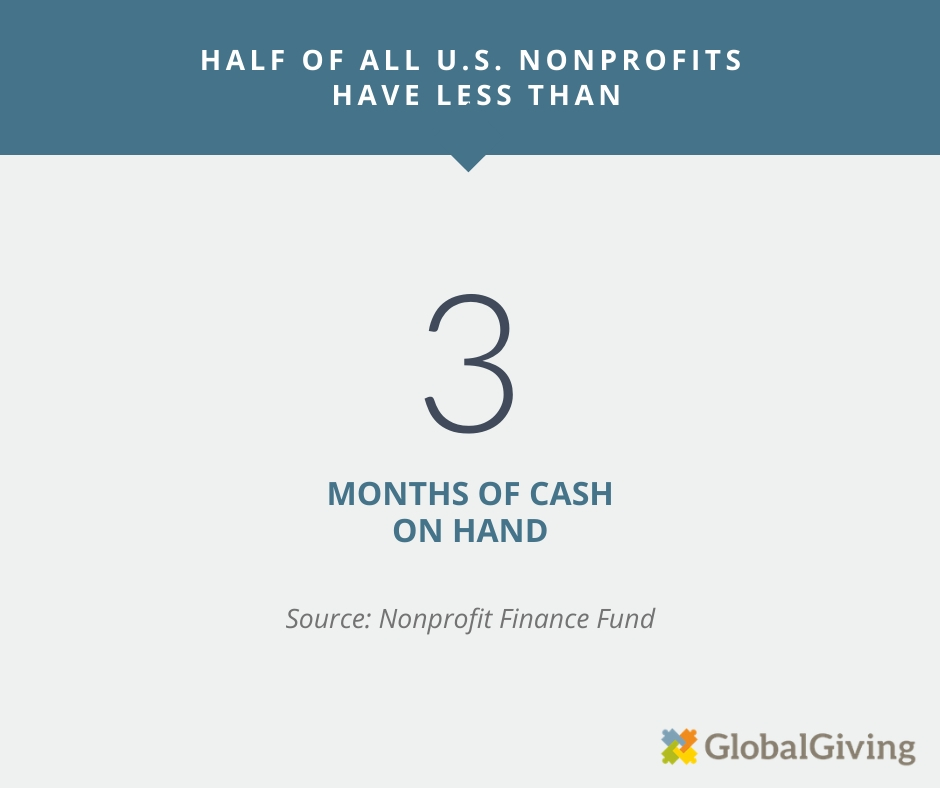GlobalGiving’s data scientist turned to natural language processing techniques to analyze nonprofit needs amid the COVID-19 crisis.
The COVID-19 pandemic has rocked the global social sector—and nonprofits around the world are dealing with cancelled fundraising events, changing programmatic needs, and the restrictions of physical distancing. With such seismic and ongoing shifts in the social, health, and economic environments in which nonprofits are operating, pinning down trends and details of these new needs is exceptionally challenging.
Keeping a data-driven eye on the trends and needs in the social sector is part of my job at GlobalGiving. We connect a large + diverse network of nonprofit partners with money, information, and ideas, and as a global connector, we’re able to get a unique viewpoint into how COVID-19 is impacting nonprofits. Shortly after the WHO formally declared COVID-19 a global pandemic, we announced that we’d be making at least 100 unrestricted grants of $1,000 each to our nonprofit partners to help support them through the pandemic. We asked them to share three sentences about what they needed the funds for, and then we trusted them to run with their ideas from there—no laborious grant reporting or micro-accounting required. We received hundreds of these short applications, which gave us a candid window into what organizations actually needed that weren’t tempered by the need to tailor a detailed application to a highly restricted grant or the feeling that “I need to tell this funder what they want to hear.” They simply asked, and we listened.
What did we discover about what organizations’ needs as they look to adapt in the face of a generational public health crisis? While we had some anecdotal ideas about common themes based on our review of these microgrant applications, we wanted to explore this question in a more rigorous and reproducible way.
Fortunately, there are some helpful natural language processing techniques for modeling the underlying topics in a set of text narratives. For this problem, we used Latent Dirichlet Allocation (LDA), an unsupervised machine learning algorithm that estimates a set of underlying topics based on the words in a corpus of text, like the portfolio of microgrant applications we received. Once we know the topics, we can examine the proportion of a microgrant request represented by each topic to understand how it fits into the set of overall themes.
While the hundreds of applications we received might sound like a large dataset, it’s actually quite small when compared to many datasets one might use for natural language processing. This means that we won’t be able to clearly identify lots of precise topics, and looking for only one or two topics would likely give us results that were too noisy to parse. To help minimize noise, we also want to ignore common words (such as “of” and “the”) as well as other words that appear in so many applications that they’re not going to be helpful in understanding the underlying topic (e.g. need, help, people, COVID, and coronavirus).
With all that set up, we can start training our LDA models and examining the topics we get. This is where the “science” in this process starts to give way to “art.” To make sense of our topics, we need to look at the important words that make up each topic and determine how they fit together. After lots of exploring, we found six topic areas that highlight some key themes about what nonprofits are focused on during the pandemic. Each bubble on this chart represents one topic area, and the close two bubbles are, the more similar the topics. Digging into these groups of topics highlights three important themes.

First, many organizations are focused on the public health effects of COVID-19 and looking for ways they can help keep their communities safe. These applications contain requests for funding to purchase hand sanitizer, masks, and other cleaning equipment. We also find stories of people planning to run awareness campaigns to encourage social distancing, good hand-washing practice, and reduce community spread of the disease among the people their organizations serve.
Supporting vulnerable groups, particularly children, is another widespread concern for our partners. In the largest and broadest set of topics we encountered, many organizations shared their focus on making sure that those most at risk in their communities had the support needed to weather the crisis. Ensuring that children, women and girls, and the elderly were able to get enough food stood out as a major need. We also found a subset of applicants working in education navigating school closures, shifting to online teaching, and making sure that other important services that schools normally offer remained available.
Nonprofits are focused on operational challenges, as well. We saw two subcategories of stories here. Some organizations worried about how they’d manage to pay bills and deliver their programs with fundraising events cancelled and donations dropping. Others were rethinking how they’d be able to continue on their mission with their offices closed, staff working online, and their usual ways of connecting with their communities no longer viable during lockdowns.
Our grantmaking team reviewed hundreds of applications we received so that our first round of grants could be sent out within days. As a result, they didn’t have access to these topic labels during their review process. But, by looking retroactively at how the first round of grantmaking decisions mapped to the topics we found, we can see GlobalGiving’s unique approach to trust-based grantmaking clearly shine through.

Many of our first round of microgrants went to support the kinds of operational needs that nonprofits have a hard time getting restricted grants to fund. These usually aren’t the flashiest projects, but organizations can’t maximize their impact without nailing the fundamentals of their operations. Whether it’s buying a laptop or two so that Beyond Borders’ Child Protection Team can continue their work to protect girls in Port-au-prince remotely or funding extra tanks of gas so that the caregivers at Casa Hogar de Cabo San Lucas can still commute to their offices while public transportation isn’t running, meeting these basic needs can be the difference between an organization being able to support its community through the pandemic or not.

While we’d love to fund all the applications we received, we do have a limited pool of funds available for these microgrants. As a result, we referred many organizations who requested funds for direct public health responses to COVID-19 to our disaster recovery team for consideration to receive grants from our main Coronavirus Relief Fund. In many cases, this gave us a way to provide even more support to these organizations, like the Middle East Children’s Alliance, who are making sure that critical medical supplies are available for Palestinian refugees.
So, where do we go from here?
First, we’ve continued to send microgrants beyond our initial round. So far, thanks to the generosity of the GlobalGiving community, we’ve been able to triple our initial goal and have given out almost 300 of these grants to date. We’re also continuing to provide a place for all of our partner organizations to raise funds for their Coronavirus related needs, whatever they are. As of this writing, we have more than 500 COVID-19 projects live on GlobalGiving, with an average of five new ones being added every day since the beginning of March.

Next, it’s important to remember that these organizations represent just the tip of the iceberg. All of these organizations were already part of the GlobalGiving community, having passed our rigorous vetting process and established themselves enough to be eligible to receive these flexible funds.
While we’ve been fortunate to support hundreds of organizations, there are countless others who don’t have a way to access the kind of core operational funding they’ll need to keep the lights on and support their communities through the crisis.
According to the Nonprofit Finance Fund, half of US nonprofits surveyed in 2018 reported that they had less than 3 months of cash on hand. The longer the pandemic and economic downturn, the more the sector will struggle with operational needs.

We at GlobalGiving will continue to be there for the social sector through all this, including keeping track of the shifting needs of our partners and responding in kind wherever possible. We hope you’ll join us in whatever way you can.
Read more articles about our COVID-19 Hardship Microgrants Initiative:
Featured Photo: Urgent Support to Women During COVID-19 Crisis by Fundacion Calicanto
Find exactly what you're looking for in our Learn Library by searching for specific words or phrases related to the content you need.